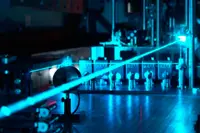 Graphene Flagship researchers have developed an optical fibre laser that can emits pulses just a few wavelengths of light in duration. The device, based on graphene, is thought to be suited to ultrafast spectroscopy and in surgical lasers.
Graphene Flagship researchers have developed an optical fibre laser that can emits pulses just a few wavelengths of light in duration. The device, based on graphene, is thought to be suited to ultrafast spectroscopy and in surgical lasers.
"When engineering light to travel in ultrashort pulses, it is important to understand its wave nature," said Daniel Popa, head of the photonics group at the Cambridge Graphene Centre. "For light to propagate as does a mechanical wave on a stretched cord, the shortest possible pulse is defined by a single wave oscillation."
In the visible and near infrared regimes, where most ultrafast lasers operate, the ultimate pulse duration lies between 2 and 5fs. Shorter pulses require shorter wavelengths.
Pulses as short as two cycles can be generated from laser cavities using a technique known as passive mode-locking. With titanium-sapphire lasers, pulses of 5fs can be produced at a wavelength of 800nm, corresponding to less than two cycles. However, these pulses are not tuneable.
Fibre lasers are said to be attractive for ultrashort pulse generation, because of their relatively simple design, efficient heat dissipation and alignment free operation. Fibre based oscillators allow ultrashort pulses to be generated by passive mode locking, which requires a nonlinear component known as a saturable absorber – and graphene has the ideal physical properties for this application.
The researchers' setup was based on standard telecommunications equipment, with a saturable absorber based on a composite of graphene and polyvinyl alcohol (PVA) fabricated by low-cost solution processing, with the graphene flakes exfoliated from bulk graphite by ultrasonic agitation of the solution. Evaporation leaves behind a 50µm thick graphene-PVA composite, which is then sandwiched between fibre connectors.
With this setup, the researchers generated 29 femtosecond pulses, corresponding to fewer than six cycles at a wavelength of 1.5µm.
Compensating for higher order nonlinear and dispersive effects should lead to a shorter pulse length, while the use of a higher power diode or a double-pumped configuration, could result in higher bandwidth pulses as well as increased output power. Finally, the addition of photonic crystal fibres could in principle allow for the generation of similarly short laser pulses at other wavelengths.
"What is truly remarkable about this project is the ease of combining graphene with off the shelf optical fibres in a highly compact format," Popa concluded.
Author
Graham Pitcher
Source: www.newelectronics.co.uk

